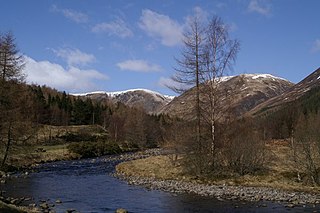
The River Don is a river in north-east Scotland. It rises in the Grampians and flows eastwards, through Aberdeenshire, to the North Sea at Aberdeen. The Don passes through Alford, Kemnay, Inverurie, Kintore, and Dyce. Its main tributary, the River Ury, joins at Inverurie.

Kincardineshire or the County of Kincardine, also known as the Mearns, is a historic county, registration county and lieutenancy area on the coast of north-east Scotland. It is bounded by Aberdeenshire on the north, and by Angus on the south-west.

The River Dee is a river in Aberdeenshire, Scotland. It rises in the Cairngorms and flows through southern Aberdeenshire to reach the North Sea at Aberdeen. The area it passes through is known as Deeside, or Royal Deeside in the region between Braemar and Banchory because Queen Victoria came for a visit there in 1848 and greatly enjoyed herself. She and her husband, Prince Albert, built Balmoral Castle there which replaced an older castle.

Dumfriesshire or the County of Dumfries or Shire of Dumfries is a historic county and registration county in southern Scotland. The Dumfries lieutenancy area covers a similar area to the historic county.

The Mounth is the broad upland in northeast Scotland between the Highland Boundary and the River Dee, at the eastern end of the Grampians.

The River Esk, also known as the Border Esk, is a river that rises in the Scottish region of Dumfries and Galloway before crossing the border to the English county of Cumbria and flowing into the Solway Firth.

Alexander Penrose Forbes was a Scottish Episcopalian divine, born in Edinburgh. A leading cleric in the Scottish Episcopal Church, he was Bishop of Brechin from 1847 until his death in 1875.

Aberdeenshire or the County of Aberdeen is a historic county in Scotland. The county gives its name to the modern Aberdeenshire council area, which covers a larger area than the historic county. The historic county ceased to be used for local government purposes in 1975, but its boundaries are still used for certain functions, being a registration county. The area of the historic county excluding the Aberdeen City council area is also a lieutenancy area.
Saint Drostan, also Drustan, was the founder and abbot of the monastery of Old Deer in Aberdeenshire. His relics were translated to the church at New Aberdour and his holy well lies nearby.

Edzell is a village in Angus, Scotland. It is 5 miles (8 km) north of Brechin, by the River North Esk. Edzell is a Georgian-era planned town, with a broad main street and a grid system of side streets. Originally called Slateford, Edzell was renamed in 1818 after an earlier hamlet 1.5 miles (2.5 km) to the west, which by then had been abandoned. Edzell's population in 2004 was 780.

Tarfside is a small hamlet in Angus, Scotland. It is situated in Glen Esk, on the upper course of the River North Esk, around 8 miles north of Edzell, and has a footpath to nearby Loch Lee. Tarfside is commonly seen as a very beautiful place for walkers.

The South Esk is a river in Angus, Scotland. It rises in the Grampian Mountains at Loch Esk in Glen Doll and flows through Glen Clova to Strathmore at Cortachy, 5 km north of Kirriemuir. Its course takes it past Brechin and enters the North Sea at Montrose.

The Water of Aven is a tributary of the Water of Feugh, itself the largest tributary of the River Dee, Aberdeenshire, Scotland. The Water of Aven rises at Loch Tennet, where the historic counties of Aberdeenshire, Angus and Kincardineshire meet and flows for approximately 15 km to its confluence with the Feugh near Whitestone. The Water of Aven forms the historic boundary between Aberdeenshire and Kincardineshire for its entire length and the lower 4.5 km are designated as part of the River Dee Special Area of Conservation, due to its importance for Atlantic salmon and Eurasian otter.

Glen Mark is a glen in northern Angus, eastern Scotland, through which the Water of Mark flows. Near the mouth of the glen, at Auchronie, the Water of Mark is joined by the Water of Lee from Loch Lee to become the River North Esk. This flows through Glen Esk, one of the Five Glens of Angus. The land is managed by the Dalhousie estate.

Millden is a hamlet, estate and farmstead in Glenesk, Angus, Scotland. It is situated in the upper course of the Glen Esk valley, where the Burn of Turret meets the River North Esk, around 7+1⁄2 miles (12.1 km) north of Edzell,

Glenesk Folk Museum is a museum located in the Glen Esk valley, in Tarfside, Angus, Scotland. It is about 9 miles (14 km) north of the village of Edzell. It is housed in a former shooting lodge, known as 'The Retreat', which used to belong to the Earls of Dalhousie. The museum contains artefacts and documents related to the history of the surrounding area. It also has a shop selling locally produced gifts and a tearoom. The museum organises demonstrations of local skills and crafts.

James Matthews was a prominent 19th-century architect in northern Scotland who also served as Lord Provost of Aberdeen from 1883 to 1886 during which time he enacted an important city improvement plan. His work as an architect is largely in the Scots baronial style.

The Callater Burn is a river in the Scottish council area of Aberdeenshire. Queen Victoria's last excursion with her husband Prince Albert, who died in 1861, is said to have taken place on 16 October of the same year through Glen Clunie to Glen Callater, which Albert is said to have admired for its beauty.



















